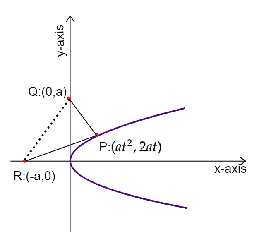Question
Question: The point P on the parabola \({{y}^{2}}=4ax\) for which \(\left| PR-PQ \right|\) is maximum, where \...
The point P on the parabola y2=4ax for which ∣PR−PQ∣ is maximum, where R(−a, 0) and Q (0, a) is,
A. (a,2a)
B. (a,−2a)
C. (4a,4a)
D. (4a,−4a)
Solution
Firstly, draw a diagram to represent the coordinates and the parabola and then decide which length will be denoting the maximum length of ∣PR−PQ∣ . This is possible when PQR is a line. Now equate the slopes of PQ and PR. Use the general denotation for any point on the parabola and then find the coordinate of P.
Complete step-by-step solution:
The given equation of the parabola is y2=4ax
Let P be any point on the parabola.
Any point on a parabola is generally denoted by the coordinates,
P(at2,2at)
Its diagrammatic representation is given by,

When we look at the triangle PQR,
We can say that always,
⇒∣PR−PQ∣≤QR
Hence the maximum value of ∣PR−PQ∣ will be QR.
The maximum value of ∣PR−PQ∣ is QR and is achieved when PQR is a straight line.
And for PQR to be a straight line,
The slope of PR must be equal to the slope of PQ.
Now let us write the slope form for the above condition.
We know that P(at2,2at) ,
And R(−a, 0) and Q (0, a)
Upon substituting in slope equations, we get,
⇒(at2+a2at−0)=(at2−02at−a)
Now evaluate to find the value of t from the expression.
⇒(at2+a2at)=(at22at−a)
Cancel ‘a’ from both sides as it is common on the numerator and denominator.
⇒(t2+12t)=(t22t−1)
Now cross multiply the expressions.
⇒2t×t2=(t2+1)(2t−1)
Evaluate further.
⇒2t3=2t3−t2+2t−1
Now, cancel the common terms on both sides of the expression.
⇒t2−2t+1=0
⇒(t−1)2=0
Which upon solving gives us t=1
Now substitute this in the general coordinates of P(at2,2at) ,
We get,
⇒P(a(1)2,2a(1))
⇒P(a,2a)
Hence option A is correct.
Note: The slope of a line is the steepness of a line in a horizontal or vertical direction. The slope of a line can be calculated by taking the ratio of the change in vertical dimensions upon the change in horizontal dimensions.
